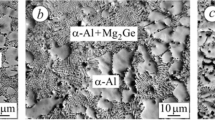Abstract
The electrochemical and corrosion behavior of four alloys (wt %) is investigated: Al–6Ca (further Al6Ca), Al–6Ca–1Fe (further Al6Ca1Fe), Al–1Fe (further Al1Fe), and Ak12M2. An increased iron content (up to 1%) in alloys is necessary for the high productivity of casting under pressure. Electrochemical studies are performed in a 3% aqueous NaCl solution at 26 ± 0.5°C using an IPC-Pro 3A digital potentiostat (IPC-2000). Anodic polarization is performed in a potentiodynamic mode with a potential scan rate of 1 mV/s. The initial polarization potential is–800 mV with respect to the standard hydrogen electrode. The direction of the potential scan was changed to inverse upon the “critical” current density icr = 10 mA/cm2 performing polarization with the same rate. The tendency of the alloy to form pits was judged by the ratio of amounts of electricity that passed through the electrode before pitting formation and their repassivation (Qfor/Qinv) and values of pitting resistance bases: the difference in the pitting formation potential and stationary potential and the difference in the repassivation potential and stationary potential. Corrosion tests of casting aluminum alloys were performed holding the samples in a salt fog chamber and in a 3% aqueous NaCl solution for 700 h. After these holdings, the surface morphology of the samples was investigated using an Olympus GX51 optical microscope. It is established that Al6Ca1Fe and Al6Ca experimental alloys, in contrast to the AK12M2 industrial alloy and Al1Fe alloy, are not subjected to pitting corrosion in a 3% aqueous NaCl solution. It is assumed that the increased corrosion resistance of Al6Ca1Fe alloy is caused by the fact that iron enters the Al10CaFe2 intermetallic compound, which is not an efficient cathode because of the considerable negative potentials of Al and Ca. Due to the high casting and mechanical properties of the Al6Ca1Fe alloy, which are no worse than the properties of eutectic silumin and surpass them by the corrosion resistance, the Al6Ca1Fe alloy is promising for use in an industrial scale.
Similar content being viewed by others
References
Kaufman, J.G. and Rooy, L.E., Aluminum Alloy Castings: Properties, Processes and Applications, Materials park: ASM International, 2004.
Zolotorevskii, V.S. and Belov, N.A., Metallovedenie liteinykh alyuminievykh splavov (Materials Science of Casting Aluminum Alloys), Moscow: MISIS, 2005.
Belov, N.A., Savchenko, S.V., and Belov, V.D., Atlas mikrostruktur promyshlennykh siluminov (Atlas of Microstructures of Industrial Silumins), Moscow: MISIS, 2009.
GOST 1583–93. Aluminum Casting Alloys: Moscow, 1993.
Sinyavskii, V.S., Val’kov, V.D., and Kalinin, V.D., Korroziya i zashchita alyuminievykh splavov (Corrosion and Protection of Aluminum Alloys), Moscow: Metallurgiya, 1986.
Sinyavskii, V.S., Pitting and stress corrosions of aluminum alloys; correlation between them, Prot. Met. Phys. Chem. Surf., 2001, vol. 37, no. 5, pp. 469–478.
Pereira, M., Silva, J., Acciari, H., Codaro, E., and Hein, L., Morphology characterization and kinetics evaluation of pitting corrosion of commercially pure aluminum by digital image analysis, Mater. Sci. Appl., 2012, vol. 3, pp. 287–293. http://dx.doi.org/10.4236/msa.2012.35042.
Frankel, G.S., Pitting corrosion of metals, J. Electrochem. Soc., 1998, vol. 145, no. 6, pp. 2186–2198.
Szklarska-Smmialowska, Z., Pitting corrosion of aluminum, Corros. Sci., 1999, vol. 41, no. 9, pp. 1743–1767.
McCafferty, V., Sequence of steps in the pitting of aluminum by chloride ions, Corros. Sci., 2003, vol. 45, no. 45, pp. 1421–1438.
Rao, K.S. and Rao, K.P., Pitting corrosion of heattreatable aluminium alloys and welds: a review, Trans. Indian Inst. Met., 2004, vol. 57, no. 6, pp. 593–610.
Baumgartner, M. and Kasche, H., Aluminium pitting in chloride solutions: morphology and pit growth kinetics, Corros. Sci., 1990, vol. 31, pp. 231–236.
Codaro, E.N., Nakazato, R.Z., Horovistiz, A.L., Ribeiro, L.M.F., Ribeiro, R.B., and Hein, L.R.O., An image processing method for morphology characterization and pitting corrosion evaluation, Mater. Sci. Eng., 2002, vol. 334, nos. 1–2, pp. 298–306.
Angal, R., Korroziya i zashchita ot korrozii (Corrosion and Corrosion Protection), Dolgoprudnyi: Intellekt, 2013.
Revie, R.W. and Uhlig, H.H., Corrosion and Corrosion Control, NJ: Wiley, 2008, 4th ed.
Punckt, C. and Bolscher, M., Rotermund H.H, Mikhailov A. S., Organ L., Budiansky N. Sudden onset of pitting corrosion on stainless steel as a critical phenomenon, Science, 2004, vol. 305, no. 5687, pp. 1133–1136.
Zhuk, N.P., Kurs korrozii i zashchity metallov (Course of Corrosion and Protection of Metals), Moscow: Metallurgiya, 1976.
Tomashov, N.D. and Chernova, G.P., Teoriya korrozii i korrozionno-stoikie konstruktsionnye splavy (Theory of Corrosion and Corrosion-Resistant Construction Alloys), Moscow: Metallurgiya, 1986.
Kaesche, H., Die korrosion der metalle. Physikalischchemische prinzipien und aktuelle probleme, Springer, 2011.
Belov, N.A., Naumova, E.A., and Akopyan, T.K., Evtekticheskie splavy na osnove alyuminiya: novye sistemy legirovaniya (Eutectic Alloys Based on Aluminum: New Alloying Systems), Moscow: Ruda i metally, 2016.
GOST 9.912-89. ESZKS. Corrosion-Resistant Steels and Alloys. Methods of Accelerated Tests for Resistance to Pitting Corrosion, Moscow, 1993.
Rozenfel’d, I.L., Korroziya i zashchita metallov (Corrosion and Protection of Metals), Moscow: Metallurgiya, 1969.
Author information
Authors and Affiliations
Corresponding author
Additional information
Original Russian Text © O.V. Volkova, A.V. Dub, A.G. Rakoch, A.A. Gladkova, M.E. Samoshina, 2017, published in Izvestiya Vysshikh Uchebnykh Zavedenii, Tsvetnaya Metallurgiya, 2017, No. 5, pp. 75–81.
About this article
Cite this article
Volkova, O.V., Dub, A.V., Rakoch, A.G. et al. Comparison of the Tendency to Pitting Corrosion of Casting of Al6Ca, Al1Fe, and Al6Ca1Fe Experimental Alloys and AK12M2 Industrial Alloy. Russ. J. Non-ferrous Metals 58, 644–648 (2017). https://doi.org/10.3103/S1067821217060153
Received:
Accepted:
Published:
Issue Date:
DOI: https://doi.org/10.3103/S1067821217060153




